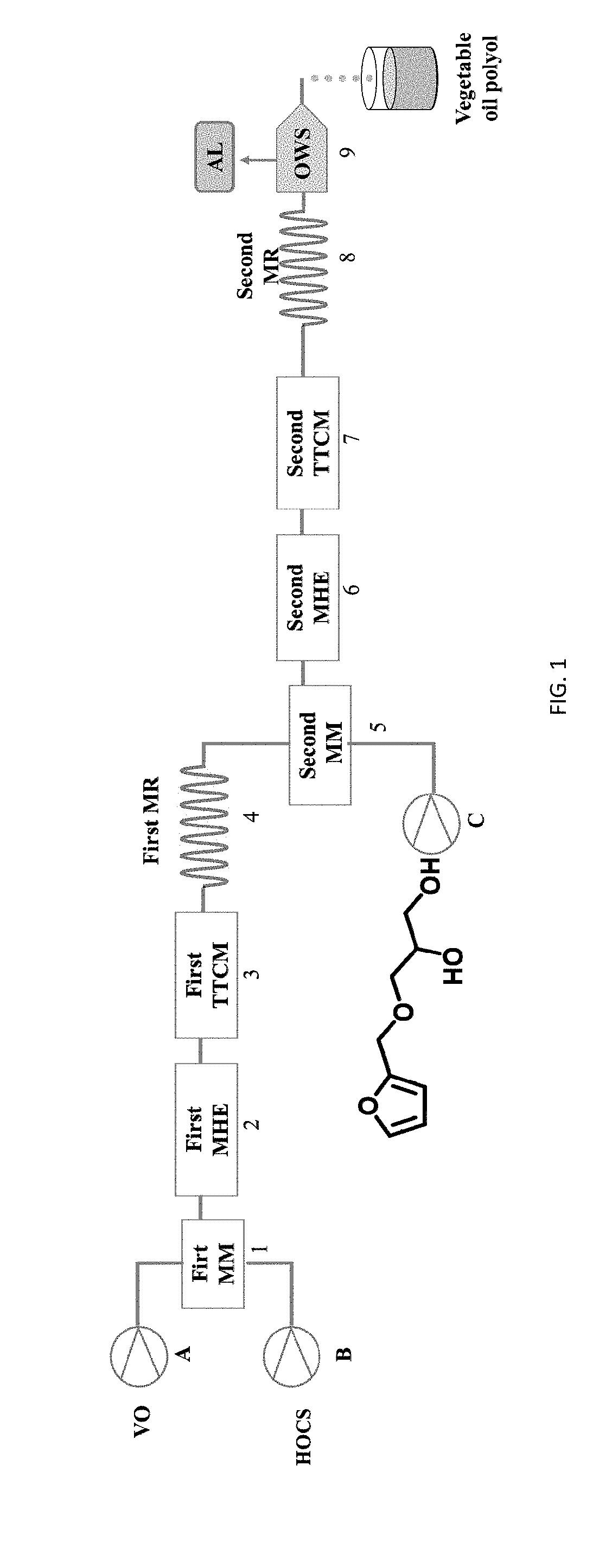Totally bio-based vegetable oil polyol and preparation method and use thereof
a vegetable oil polyol and bio-based technology, applied in the field of chemical materials and production techniques, can solve the problems of long reaction time, high energy consumption, low equipment self-control level, etc., and achieve the effects of low hydroxyl value, low hydroxyl value of a product, and high viscosity of a produ
- Summary
- Abstract
- Description
- Claims
- Application Information
AI Technical Summary
Benefits of technology
Problems solved by technology
Method used
Image
Examples
example 1
[0057](1) Preparation of the Compound of the Formula III
[0058]196.2 g (2 mol) furfuryl alcohol (a compound of a formula I) was dissolved in 4 L dichloromethane, thionyl chloride (145.26 mL, 2 mol) was dropwise added into the solution at 0° C. slowly, stirring and reacting were performed at 0° C. for 1 h, and 4 L water was added to quench the reaction. An organic layer was collected and an aqueous layer was washed for three times with dichloromethane. The organic layer was combined and the solvent was spin-dried, so as to obtain colorless liquid. 184.18 g glycerol (2 mol) and 46 g sodium (2 mol) were added into the liquid and stirring and reacting were continued for 4 h at 40° C. 500 mL water was added. The organic layer was separated. The aqueous layer was extracted with toluene (250 mL*3) and the organic layer was combined. The combined organic layer was dried with anhydrous sodium sulfate and the toluene was recovered by distillation. Atmospheric distillation was carried out to ob...
example 2
[0061](1) Preparation of the Compound of the Formula III
[0062]196.2 g (2 mol) furfuryl alcohol (the compound of the formula I) was dissolved in 4 L dichloromethane, thionyl chloride (217.89 mL, 3 mol) was dropwise added into the solution at 0° C. slowly, stirring and reacting were performed at 0° C. for 2 h, and 4 L water was added to quench the reaction. An organic layer was collected and an aqueous layer was washed for three times with dichloromethane. The organic layer was combined and the solvent was spin-dried, so as to obtain colorless liquid. 184.18 g glycerol (2 mol) and 46 g sodium (2 mol) were added into the liquid and stirring and reacting were continued for 4 h at 40° C. 500 mL water was added. The organic layer was separated. The aqueous layer was extracted with toluene (250 mL*3) and the organic layer was combined. The combined organic layer was dried with anhydrous sodium sulfate and the toluene was recovered by distillation. Atmospheric distillation was carried out t...
example 3
[0065](1) Preparation of the Compound of the Formula III
[0066]196.2 g (2 mol) furfuryl alcohol (the compound of the formula I) was dissolved in 4 L dichloromethane, thionyl chloride (217.89 mL, 3 mol) was dropwise added into the solution at −5° C. slowly, stirring and reacting were performed at 0° C. for 2 h, and 4 L water was added to quench the reaction. An organic layer was collected and an aqueous layer was washed for three times with dichloromethane. The organic layer was combined and the solvent was spin-dried, so as to obtain colorless liquid. 276.27 g glycerol (3 mol) and 69 g sodium (3 mol) were added into the liquid and stirring and reacting were continued for 4 h at 35° C. 500 mL water was added. The organic layer was separated. The aqueous layer was extracted with toluene (250 mL*3) and the organic layer was combined. The combined organic layer was dried with anhydrous sodium sulfate and the toluene was recovered by distillation. Atmospheric distillation was carried out ...
PUM
| Property | Measurement | Unit |
|---|---|---|
| volume | aaaaa | aaaaa |
| temperature | aaaaa | aaaaa |
| volume | aaaaa | aaaaa |
Abstract
Description
Claims
Application Information
 Login to View More
Login to View More - R&D
- Intellectual Property
- Life Sciences
- Materials
- Tech Scout
- Unparalleled Data Quality
- Higher Quality Content
- 60% Fewer Hallucinations
Browse by: Latest US Patents, China's latest patents, Technical Efficacy Thesaurus, Application Domain, Technology Topic, Popular Technical Reports.
© 2025 PatSnap. All rights reserved.Legal|Privacy policy|Modern Slavery Act Transparency Statement|Sitemap|About US| Contact US: help@patsnap.com



